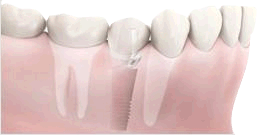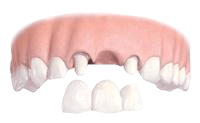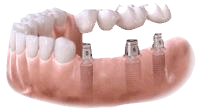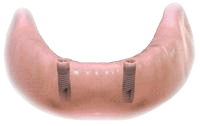Restoring function and beauty
When natural teeth are lost or are not able to be saved, quality of life can often be improved with the use of dental implants and implant-retained dentures. Dental implants with crowns would replace missing teeth and implant retained dentures provide many advantages over traditional dentures.
Aesthetically pleasing replacement teeth not only look, but feel and function like natural teeth. Single-tooth implants or a series of teeth implants help to:

- Promote “denture self-confidence,” as speech and appearance are often improved
- Reduce movement of dentures
- Facilitate proper chewing
- Provide support for removable dentures or fixed bridge work
Dr. Bateman takes your specific needs into consideration and determines the best treatment options for each patient considering dental implants.
The parts of a dental implant
A small titanium screw is inserted into your jawbone.
Titanium is a metal accepted by the body and heals together with the bone tissue to form a new, stable tooth root.

An abutment is a ceramic or titanium component that ensures a secure fit between the dental implant and the crown.

Once the dental implant and the abutment are in place, Dr. Bateman fits the crown, the bridge or the prosthesis.


A dental implant is an artificial tooth root made out of titanium that can be placed into your jawbone to replace damaged or missing teeth. There is no question that dental implants provide the highest standard of care when replacing a single tooth or restoring the entire mouth of teeth. Single implants are a great alternative to tooth supported fixed bridges because you do away with the need to cut down the neighboring teeth. Dental implants are an ideal option for people in good general oral health who have lost a tooth or teeth due to periodontal disease, an injury, or some other reason. Dental implants are so natural-looking and feeling, you may forget you ever lost a tooth.
Dental implant surgery is a procedure that replaces damaged or missing teeth with artificial teeth that look and function much like real ones.
Dental implant surgery can also offer a welcome alternative to ill-fitting dentures or bridgework.
Dental Implants are an alternative to a dental bridge or partial dentures
Traditionally in the past when you have missing teeth, a dental bridge, and or removable dentures have been presented as the standard of care to replacing the missing dentition. Dental implants are not only an alternative to bridges and dentures, they are the new standard of care today while bridges and partial dentures are the less desired alternative.

A conventional bridge is a quick way to replace a missing tooth, but involves grinding down healthy adjacent teeth to support the bridge. This can lead to that tooth being injured to the point of needing a root canal. Bridges are also difficult to clean around which can lead to dental decay around the teeth the bridge is attached.
Partial dentures can replace missing teeth, but have some risks. One risk is the stress they put on the teeth they rest. This can lead to breakdown and eventual loss of these teeth.
Full dentures are a solution for having no teeth, but when the dentures rest on the bony ridge they cause the bone to reabsorb and eventually they get loose. Eventually bone will be lost and there will not be enough bone for the dentures to rest, so the dentures will be loose all of the time.
Replacing one tooth
Step 1
The need to replace a missing tooth could be the result of an accident or because there was no predisposition for a tooth at birth.

Step 2
The dental implant is installed in the jawbone. No healthy teeth are affected or damaged. With other replacement solutions, adjacent teeth might need to be ground down to support a bridge.

Step 3
The abutment is attached to the dental implant. A crown is then placed on the abutment, fitting perfectly at the edge of the gum.

Step 4
The new tooth is now complete and it is virtually impossible to see the difference between the existing teeth and the new tooth.

Replacing several teeth
Step 1
Some people loose teeth in the back of the mouth. This is typically caused by gum infection (periodontitis) or by teeth cracking due to previous fillings.

Step 2
Between two and four dental implants are installed for a dental implant bridge. This solution does not affect your own teeth. The bridge will function for many years, regardless of the condition of your existing teeth.

Step 3
Abutments are attached to the dental implants. The next step is to fit a bridge; the new set of teeth is placed on the abutments.

Step 4
The dental implant bridge is now in place and can withstand the strong chewing forces that occur in the back of the mouth. It feels and functions like natural teeth.

Replacing all teeth
Step 1
If you have lost all your teeth in one or both jaws, you can choose a permanently anchored dental implant bridge or a removable prosthesis that is connected to two or more dental implants. This is called an overdenture. This type of overdenture remains in place more firmly than a conventional removable prosthesis. For the most natural looking solution, the permanently anchored dental implant bridge is the answer when the prerequisites are met.

Step 2
For a permanently anchored dental implant bridge, several dental implants are installed to form a good foundation. Because the dental implants are anchored in the jawbone, they stimulate the bone tissue and help to maintain healthy bone levels and facial structures.
An overdenture involves installing two or more dental implants that will be used as a secure foundation to attach the prosthesis.


Step 3
The abutments are attached to the dental implants and the bridge is fitted in place. All dental work is performed according to your prerequisites and wishes.
For the overdenture, either ball abutments or a small bar between the abutments are used. The prosthesis is fitted with corresponding devices underneath.


Step 4
The dental implant bridge, or the overdenture, is now in place. It looks and functions like normal teeth. You can now eat whatever you like and laugh without having to worry about the prosthesis falling out.

Six reasons why you should consider implants
- They look, feel and function like your natural teeth
- Healthy teeth do not need to be ground down to support the dental implants
- Anchoring dental implants in the jawbone stimulates bone tissue and gums, ensuring an attractive, aesthetic result while helping to maintain facial structures
- Dental implants do not require any adhesives to hold the new teeth in place
- They eliminate the discomfort and insecurity of loose, ill-fitting dentures
- You have a secure, permanent tooth replacement

